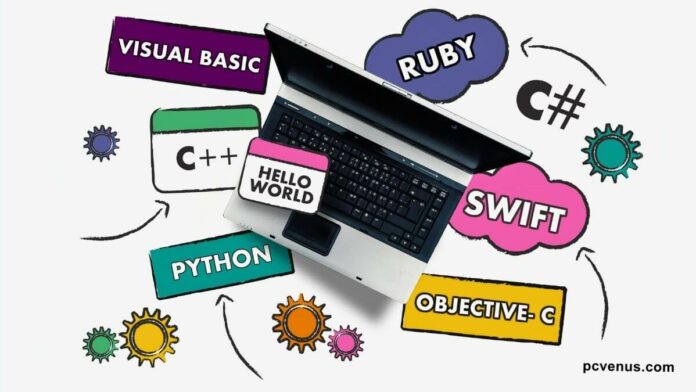Nowadays, programming languages play a crucial role in the advancement of technology. Whether you’re a full-time developer or just stepping into the coding, understanding the most popular programming languages is essential.
In this article, we’ll explore the top programming languages, their importance, and why you should consider learning them. And what will be the benefit after learning?
What is a programming language?
A programming language is a set of instructions and rules to communicate with a computer and develop software applications.
Programming languages are the backbone of software development. They are the tools that developers use to create applications, websites, and software solutions that power our modern and tech era. Certain programming languages have become prominent as technology advances due to their versatility, efficiency, and demand in the job market.
Why are programming languages important?
Programming languages provide a way for programmers to write code that the computer can understand and execute.
The purpose of programming languages is to enable developers to create various software applications, ranging from simple scripts to complex systems. They serve as a means of communication between humans and computers, allowing programmers to express their ideas and algorithms in a structured and logical manner.
Programming languages are used in software development to design, write, and maintain code. These languages allow developers to manipulate data, perform calculations, control program flow, and interact with external resources.
Programming languages also play a crucial role in enabling collaboration among developers. They provide a common vocabulary and syntax that programmers can understand and share. This facilitates teamwork, code sharing, and code reuse, making it easier for multiple developers to work on a project simultaneously.
Recommended Article: Best Budget Laptops for Programming
What are the most popular programming languages?
1. Python

Python is a high-level, interpreted, and open sourced programming language known for its simplicity and readability. It was created by Guido van Rossum and first released in 1991. Python emphasizes code readability and clean syntax, making it a popular choice for beginners and experienced programmers.
Key Features and Use Cases:
1. Easy to Learn
Python’s simple syntax and extensive documentation make it accessible to beginners, allowing them to learn programming fundamentals quickly.
2. Versatile
Various domains use Python, a general-purpose language, including web development, data analysis, machine learning, scientific computing, artificial intelligence, and automation.
3. Extensive Libraries
Python has a rich ecosystem of libraries and frameworks, including NumPy, Pandas, TensorFlow, Django, and Flask, which provide ready-to-use solutions for specific tasks and simplify development.
4. Cross-Platform Compatibility
Python programs can run on different operating systems, including Windows, macOS, and Linux, without requiring modifications.
5. Interoperability
Python can be easily integrated with other languages, facilitating the incorporation of existing codebases and libraries into Python projects.
Advantages of Python
1. Readability
Python’s clean syntax and whitespace indentation make it highly readable, reducing the time and effort required for code maintenance and collaboration.
2. Productivity
Python’s simplicity and extensive standard library enable developers to write code quickly and efficiently, resulting in faster development cycles.
3. Large Community and Support
Python has a vibrant community of developers who contribute to its growth, provide support, and share resources, making it easy to find help and resources online.
Drawbacks of Python
1. Performance
Python is an interpreted language, which can lead to slower execution speed compared to compiled languages like C or C++. However, Python’s performance can be improved using libraries that leverage compiled code, such as NumPy or Cython.
2. Global Interpreter Lock (GIL)
Python’s GIL restricts the execution of multiple threads simultaneously, limiting its ability to fully utilize multicore processors in certain scenarios.
Real-World Examples and Applications
Web Development:
Python’s frameworks, like Django and Flask, are widely used for building scalable and robust web applications.
Data Science and Analytics:
Python’s libraries, such as NumPy, Pandas, and sci-kit-learn, make it popular for data analysis, machine learning, and scientific computing.
Automation and Scripting:
Python’s simplicity and cross-platform compatibility make it suitable for automating repetitive tasks.
2. JavaScript
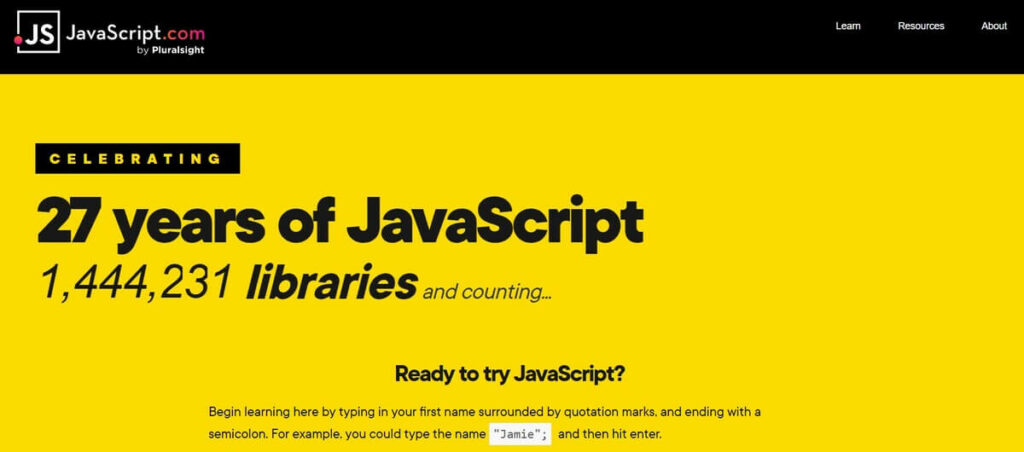
JavaScript is a versatile programming language primarily used for front-end web development. It was originally designed to add interactivity and dynamic behavior to websites, but it has evolved to become a widely used language for both front-end and back-end development.
Key Features and Use Cases
1. Client-side Scripting
JavaScript is mainly used for client-side scripting, meaning it runs directly in the user’s web browser. It allows developers to create interactive web pages that respond to user actions, validate forms, and dynamically update content without requiring a page refresh.
2. DOM Manipulation
JavaScript provides powerful APIs to manipulate and modify the Document Object Model (DOM), which represents the structure of an HTML document. This enables developers to dynamically add, remove, or modify elements on a web page, making it highly interactive and responsive.
3. Event Handling
JavaScript allows developers to handle various events triggered by user actions, such as mouse clicks, key presses, or form submissions. This enables the creation of event-driven applications and enhances the overall user experience.
4. Asynchronous Programming
JavaScript supports asynchronous programming through features like callbacks, promises, and async/await. This allows developers to write non-blocking code that can perform tasks in the background, such as making API requests or fetching data, without blocking the main execution thread.
Advantages of JavaScript
1. Wide Adoption
JavaScript is one of the most popular programming languages and has a vast ecosystem of libraries, frameworks, and resources. This makes finding support, collaborating with other developers, and leveraging existing code easy.
2. Versatility
JavaScript can be used for both front-end and back-end development. It powers interactive web applications, server-side applications (using Node.js), and even mobile applications (with frameworks like React Native).
Drawbacks of JavaScript
1. Browser Compatibility
Different web browsers may interpret JavaScript code slightly differently, leading to potential cross-browser compatibility issues. Developers must test and handle these differences to ensure consistent behavior across browsers.
2. Lack of Strong Typing
JavaScript is dynamically typed, meaning variables can hold values of any type. This flexibility can lead to potential bugs and make code harder to maintain in larger projects.
Real-World Examples and Applications
1. Website Development
JavaScript is commonly used to enhance the interactivity and functionality of websites. It creates dynamic features such as sliders, carousels, form validation, and interactive maps.
2. Web Applications
JavaScript is the backbone of many web applications, including social media platforms, online marketplaces, and productivity tools. It enables developers to create responsive and interactive user interfaces for these applications.
3. Mobile App Development
JavaScript can be used with frameworks like React Native or Ionic to develop cross-platform mobile applications. This allows developers to write code once and deploy it on both iOS and Android platforms.
4. Game Development
JavaScript is widely used for developing web-based games. It provides libraries and frameworks like Phaser and PixiJS, which offer powerful tools and functionalities for creating interactive and engaging games.
5. Data Visualization
JavaScript libraries like D3.js and Chart.js enable developers to create stunning visual representations of data. These visualizations can be embedded in websites or web applications to present complex data more understandably and interactively.
3. Java
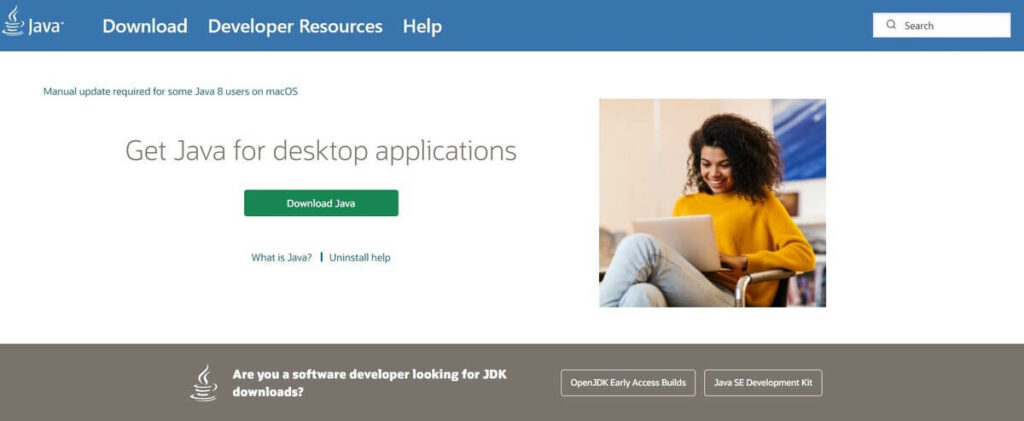
Java is a high-level, object-oriented programming language developed by Sun Microsystems (now owned by Oracle Corporation). It was first released in 1995 and has since become one of the most popular programming languages in the world.
Key Features and Use Cases
1. Platform Independence
Java programs can be written once and run anywhere, thanks to the Java Virtual Machine (JVM). This makes it suitable for developing cross-platform applications.
2. Object-Oriented
Java follows the object-oriented programming (OOP) paradigm, which allows for implementing modular, reusable, and scalable code.
3. Robust and Secure
Java includes exception handling, automatic memory management (garbage collection), and built-in security mechanisms, making it a reliable choice for building enterprise-level applications.
4. Large Standard Library
Java provides a vast standard library that offers ready-to-use classes and functions for common tasks, such as networking, database connectivity, and file handling.
Advantages of Java
1. Portability
Java’s “write once, run anywhere” capability allows applications to be deployed on multiple platforms without extensive modifications.
2. Scalability
Java’s support for multithreading and its ability to handle large amounts of data makes it suitable for building scalable applications.
3. Community and Ecosystem
Java has a large and active developer community, which means plenty of resources, libraries, and frameworks are available to support Java development.
4. Enterprise-Level Applications
Java’s robustness and security features make it a preferred choice for developing mission-critical applications in finance, healthcare, and telecommunications industries.
Drawbacks of Java
1. Performance
While Java has improved its performance over the years, it can still be slower than languages closer to the system hardware, such as C or C++.
2. Memory Consumption
Java’s automatic memory management can sometimes lead to higher memory usage than languages offering more fine-grained control over memory allocation.
Real-World Examples and Applications
1. Enterprise Software
Java is widely used to develop enterprise-level software, such as customer relationship management (CRM) systems, financial applications, and supply chain management systems.
2. Android App Development
Java is the primary programming language used for building Android applications. It provides the necessary tools and libraries to create feature-rich, platform-independent apps.
3. Web Applications
Java can be used to develop dynamic web applications using frameworks like Spring Boot or JavaServer.
4. C++
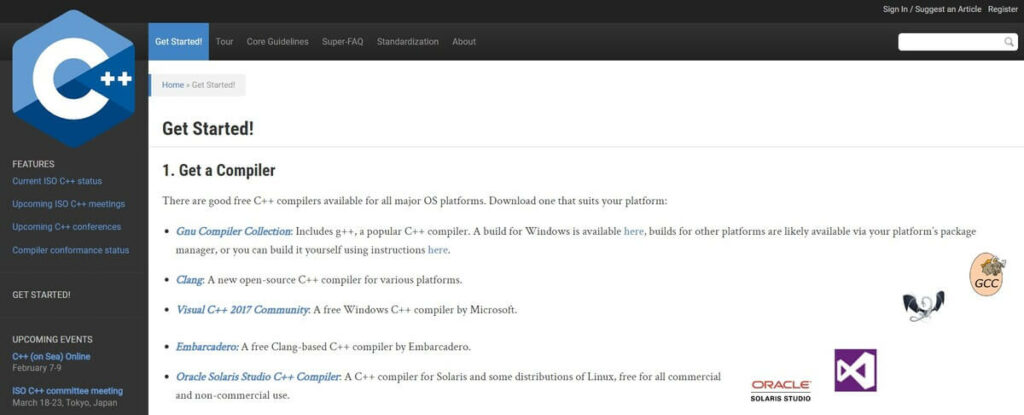
The widely used programming language, C++, provides various features and use cases, known for its performance, flexibility, and extensive library support. C++ finds application in real-world scenarios, such as operating systems, game development, GUI-based applications, web browsers, embedded systems, banking applications, compilers, and database management software.
Key features and use cases
1. Object-Oriented Programming (OOP)
C++ supports the principles of OOP, including encapsulation, inheritance, and polymorphism. This allows for the creation of reusable and modular code.
2. Strongly Typed
C++ enforces strong type-checking, which helps catch errors during compilation and promotes safer programming practices.
3. High Performance
C++ is known for its efficiency and performance. It allows for low-level memory management and direct hardware access, making it suitable for resource-intensive applications.
4. Standard Template Library (STL)
C++ provides a powerful STL that offers a collection of reusable algorithms and data structures. This library simplifies development tasks and enhances code reliability.
5. Exception Handling
C++ supports exception handling, allowing developers to gracefully handle and recover from runtime errors.
6. Interoperability
C++ can be easily integrated with other programming languages, particularly C. This makes it a popular choice for software development that requires interoperability with existing C codebases.
Advantages of C++
1. Performance
C++ allows developers to write code that can run efficiently and utilize system resources effectively, making it suitable for performance-critical applications.
2. Flexibility
C++ provides a wide range of features and programming paradigms, allowing developers to choose the most appropriate approach for their specific needs.
3. Community and Tooling
C++ has a large and active community, providing extensive resources, libraries, and frameworks. It also has robust tooling, including compilers, debuggers, and integrated development environments (IDEs).
Drawbacks of C++
1. Complexity
C++ is known for its complexity, with a large and intricate language specification. It can be challenging for beginners to grasp and master, requiring a steep learning curve.
2. Memory management
C++ requires manual memory management through operations such as allocating and deallocating memory. If not handled carefully, this can lead to issues like memory leaks and dangling pointers.
3. Lack of built-in garbage collection
C++ does not have built-in garbage collection, so developers must manually manage memory deallocation. This can make the code more error-prone and increase the risk of memory leaks.
4. Verbosity
C++ syntax can be verbose compared to other programming languages. The need for explicit type declarations and extensive boilerplate code can make development and maintenance more time-consuming.
5. Compilation time
C++ programs typically have longer compilation times compared to interpreted languages. This can slow down the development process, especially for large-scale projects.
6. Limited standard library
The standard library of C++ is not as extensive as some other programming languages. Developers often rely on third-party libraries to access certain functionalities, which can introduce compatibility and maintenance challenges.
7. Lack of standardization
The C++ language standard has evolved, leading to variations and inconsistencies among different compilers and versions. This can result in portability issues when moving code between different environments.
Real-world examples and applications
1. Operating Systems
C++ is the primary language for developing operating systems like Windows, macOS, and Linux. It provides the necessary performance and control over hardware resources required for system-level programming.
2. Game Development
C++ is a popular choice for creating games due to its efficiency and ability to access low-level system resources. Game engines like Unreal Engine and Unity are written in C++ and provide developers with powerful tools and frameworks for game development.
3. GUI-Based Applications
C++ is used for creating graphical user interfaces (GUI) in applications. Frameworks like Qt and wxWidgets are written in C++, allowing developers to create cross-platform GUI applications efficiently.
4. Web Browsers
Web browsers like Google Chrome and Mozilla Firefox use C++ for their core functionality. C++ allows for efficient memory management, fast processing, and handling of complex tasks such as rendering web pages and executing JavaScript.
5. Embedded Systems
C++ is widely used in embedded systems development, where code efficiency and performance are critical. Applications include automotive systems, medical devices, and Internet of Things (IoT) devices.
6. Banking Applications
Financial institutions rely on C++ to develop secure and high-performance banking applications. C++ offers the necessary performance and control to handle complex financial calculations, data processing, and transaction management.
7. Compilers
C++ is often used to develop compilers and interpreters for other programming languages. The flexibility and low-level control provided by C++ are essential for building efficient and powerful compiler systems.
8. Database Management Software
C++ is utilized to develop database management systems (DBMS) like MySQL and PostgreSQL. C++ allows for efficient data processing, indexing, and management, making it suitable for handling large amounts of data.
5. Ruby
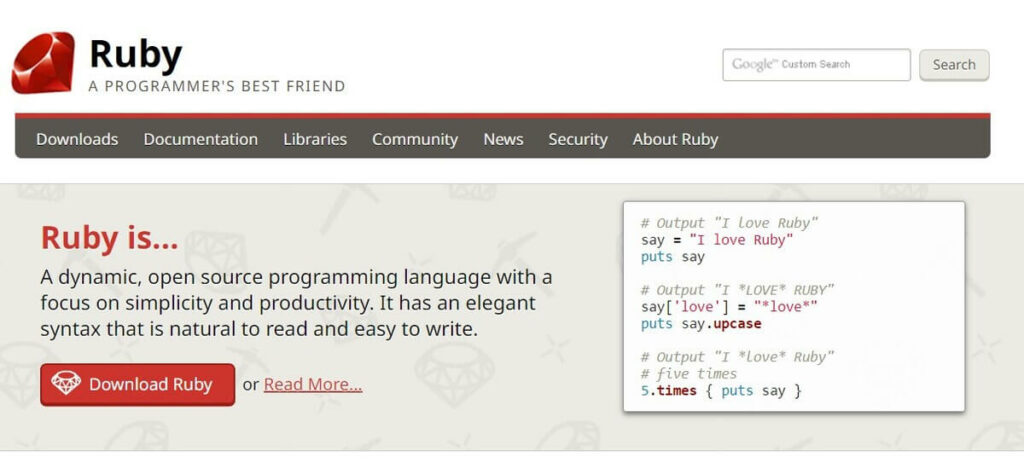
Ruby is a dynamic, high-level programming language known for its simplicity and readability. Developed in the mid-1990s by Yukihiro Matsumoto, Ruby has gained popularity for its elegant syntax and focus on developer productivity.
Key Features and Use Cases
1. Easy-to-Read Syntax
Ruby’s syntax is designed to be natural and easy to read, resembling plain English. This makes it a great choice for beginners and enhances developer productivity.
2. Dynamic Typing
Ruby is dynamically typed, allowing for flexibility and ease of use. Developers do not need to declare variable types explicitly, making code easier to write and understand.
3. Object-Oriented Programming
Ruby is a fully object-oriented language, meaning everything in Ruby is an object. This allows developers to create reusable and modular code using classes and objects.
4. Rails Framework
Ruby on Rails, commonly referred to as Rails, is a popular web application framework built using Ruby. Rails embraces convention over configuration, providing a clean and efficient way to build robust web applications.
5. Metaprogramming Capabilities
Ruby’s powerful metaprogramming capabilities allow developers to modify and extend the language. This enables advanced features such as dynamic method generation and code introspection.
Ruby is widely used in various domains, including web development, scripting, and automation. It is well-suited for building web applications, APIs, and command-line tools. Ruby’s expressive syntax and powerful libraries make it popular for startups and small-to-medium-sized projects.
Advantages of Ruby
1. Simplicity
Ruby’s clean and easy-to-read syntax promotes a straightforward and intuitive coding experience.
2. Productivity
Ruby’s focus on developer happiness and productivity allows for faster development cycles and reduced time to market.
3. Large Ecosystem
Ruby benefits from a vibrant and extensive ecosystem of open-source libraries and gems, enabling developers to leverage existing solutions for common tasks.
4. Rails Framework
Ruby on Rails provides a well-structured framework for building web applications, speeding up development, and promoting best practices.
Drawbacks of Ruby
1. Performance
Ruby is not known for its high performance compared to other programming languages like C++ or Java. It may not be the best choice for computationally intensive tasks or applications that require high-speed processing.
2. Memory Usage
Ruby can be memory intensive, especially when dealing with large data sets or running multiple processes concurrently. This can lead to higher memory consumption compared to some other programming languages.
3. Scalability
Ruby may not be the best choice for building highly scalable applications that need to handle a large number of concurrent users or high-volume data processing. It may struggle to handle heavy loads and require additional optimization or architectural considerations.
4. Threading and Concurrency
Ruby’s Global Interpreter Lock (GIL) can limit its ability to utilize multi-core processors for parallel processing fully. While Ruby supports threads, it may not achieve true parallelism in all scenarios due to the GIL.
Real-World Examples and Applications
1. Web Development
Ruby on Rails (RoR) is a popular web application framework built with Ruby. Many companies and startups use it to develop scalable and robust web applications. Some examples include GitHub, Airbnb, Shopify, and Basecamp.
2. Scripting and Automation
Ruby’s concise syntax and ease of use suit it for scripting and automation tasks. It is often used for writing scripts to automate repetitive tasks, such as file processing, data manipulation, and system administration.
3. Prototyping
Ruby’s flexibility and expressiveness make it a popular choice for rapidly prototyping software solutions. Its concise syntax and extensive libraries enable developers to quickly build and iterate on ideas.
4. DevOps and Infrastructure Automation
Ruby has gained popularity in the DevOps community for tools like Chef and Puppet, which automate infrastructure provisioning, configuration management, and deployment.
5. Data Analysis and Processing
Ruby has libraries like NArray and NMatrix that provide numerical computing capabilities. It can be used for data analysis, scientific computing, and processing large datasets.
6. Game Development
Ruby has game development frameworks like Gosu and Rubygame, enabling developers to create 2D games and simulations.
6. Swift
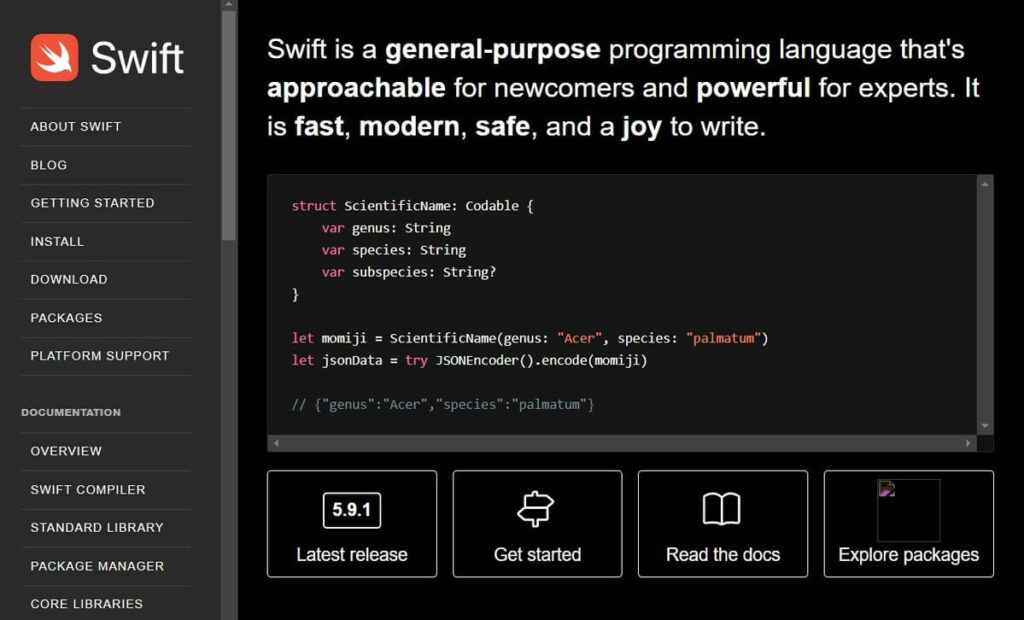
Swift is a powerful and modern programming language developed by Apple. It was designed to be fast, safe, and expressive, making it a popular choice for developing iOS, macOS, watchOS, and tvOS applications.
Key Features and Use Cases
1. Safety
Swift incorporates modern language features to ensure safer code. It provides strong type inference, optionals to handle nil values, and automatic memory management through ARC (Automatic Reference Counting).
2. Expressiveness
Swift offers a concise and expressive syntax, making it a joy to write and read. It supports features like closures, type inference, and generics, enabling developers to write clean and elegant code.
3. Performance
Swift is built with performance in mind. It is designed to optimize code execution and utilizes modern compiler technologies. Swift can be as fast as Objective-C and even outperform it in certain scenarios.
4. Compatibility
Swift is highly compatible with Objective-C code, allowing developers to seamlessly integrate Swift into their projects. It provides interoperability with Objective-C frameworks and libraries, making leveraging existing iOS and macOS ecosystems easy.
5. Multi-platform Development
Swift is not limited to Apple platforms. The advent of Swift on Linux has also become a viable option for server-side development. This allows developers to build full-stack applications using Swift.
Advantages of Swift
1. Safety and Reliability
Swift’s strong type system and safety features help reduce crashes and improve code reliability.
2. Developer-friendly
Swift’s modern syntax and features make it developer-friendly and enjoyable to work with.
3. Performance
Swift’s performance is comparable to low-level languages like C and C++, making it well-suited for performance-critical tasks.
Drawbacks of Swift
1. Learning Curve
Swift is a relatively new language, so developers may need time to learn its intricacies and best practices.
2. Limited Legacy Support
Swift’s compatibility with older Objective-C code may not be perfect, and there may be some challenges in migrating existing projects.
3. Platform Limitation
Swift is primarily used for Apple platforms, which limits its use to iOS, macOS, watchOS, and tvOS development.
Real-World Examples and Applications
1. iOS Development
Swift is the primary programming language for developing iOS applications. It is used to create apps for iPhone, iPad, and other Apple devices. Swift’s modern syntax, powerful features, and seamless integration with Apple’s frameworks make it a popular choice among iOS developers.
2. macOS Development
Swift can also be used to develop applications for macOS. It allows developers to create native macOS apps with the same ease and efficiency as iOS apps. Swift’s compatibility with Apple’s frameworks, such as Cocoa and Cocoa Touch, allows for seamless development across Apple’s platforms.
3. Server-Side Development
Swift can be used for server-side development thanks to frameworks like Vapor and Kitura. These frameworks enable developers to build powerful and scalable web applications using Swift. Swift’s safety features, performance, and ease of use make it an attractive choice for server-side development.
4. Machine Learning
Swift has gained traction in the field of machine learning. Libraries like TensorFlow and Core ML have been integrated with Swift, allowing developers to build and train machine learning models using the language. Swift’s speed and safety features make it well-suited for machine learning tasks.
5. Augmented Reality (AR)
Swift is used in the development of AR applications. Apple’s ARKit framework, which enables the creation of immersive AR experiences on iOS devices, is often used in conjunction with Swift. Swift’s capabilities and compatibility with Apple’s AR technologies make it a powerful tool for building AR applications.
6. Game Development
Swift is increasingly being used for game development. The SpriteKit and SceneKit frameworks, which are part of Apple’s game development framework, allow developers to create 2D and 3D games using Swift. Swift’s performance, ease of use, and integration with Apple’s frameworks make it a popular choice for game developers.
7. Go

Go, also known as Golang, is an open-source programming language developed by Google. It was designed to provide a simple, efficient, and reliable way to build scalable software systems. Go combines the performance and safety of a statically typed language with the simplicity and readability of a dynamically typed language.
Key Features and Use Cases
1. Simplicity
Go has a simple and concise syntax, making it easy to read and write. It avoids unnecessary complexity and provides a smaller language specification than other languages.
2. Concurrency
Go has built-in support for concurrent programming, making writing efficient and scalable concurrent applications easy. It provides goroutines (lightweight threads) and channels for communication and synchronization between goroutines.
3. Fast Compilation
Go has a fast compilation speed, allowing developers to build and deploy their applications quickly. This is particularly useful for projects with large codebases or frequent iterations.
4. Garbage Collection
Go includes a garbage collector that automatically manages memory allocation and deallocation, relieving developers from manual memory management tasks.
5. Cross-Platform Support
Go is designed to be platform-independent, allowing developers to write code that can be compiled and run on different operating systems without modification.
Advantages of Go
1. Performance
Go provides high performance due to its efficient compilation and runtime. It is often used in systems programming and building networks or web servers that require fast response times.
2. Scalability
The built-in concurrency primitives in Go Programming Language make writing concurrent and parallel programs easy. This allows applications to utilize multiple cores and handle many concurrent requests efficiently.
3. Ease of Use
Go’s simplicity and readability make it easy for developers to learn and maintain. Its minimalistic approach to language design reduces complexity and makes code easier to understand and debug.
4. Strong Standard Library
Go has a rich standard library that provides a wide range of functionality, including networking, cryptography, and file handling. This reduces the need for third-party libraries and simplifies the development process.
Drawbacks of Go
1. Lack of Generics
Go does not currently support generic types, which can make certain data structures and algorithms more complex to implement. However, there are workarounds and proposals to introduce generics in future versions of Go.
2. Immature Ecosystem
Compared to more established languages, the Go ecosystem may be considered less mature. While it has a growing number of libraries and frameworks, the selection may be more limited than languages with longer histories.
Real-World Examples and Applications
1. Web Development
Go is commonly used for building web applications and APIs. Its simplicity, efficiency, and built-in support for concurrency make it well-suited for handling high-traffic web services. Popular frameworks like Revel and Gin are built in Go.
2. Networking
Go’s networking capabilities make it ideal for developing network applications and tools. It provides a robust standard library for tasks such as building servers, handling HTTP requests, and working with protocols like TCP and UDP.
3. Cloud Infrastructure
Go has gained popularity in the cloud computing industry due to its efficiency and ease of deployment. Projects like Kubernetes, Docker, and Prometheus are written in Go, enabling efficient containerization, orchestration, and monitoring of applications.
4. Distributed Systems
Go’s lightweight goroutines and channels make it a powerful language for developing concurrent and distributed systems. It is used in projects like etcd, a distributed key-value store, and CockroachDB, a distributed SQL database.
5. DevOps Tools
Go’s simplicity, static typing, and speed make it popular for building command-line tools and utilities. Popular examples include Terraform for infrastructure provisioning, Helm for managing Kubernetes applications, and Grafana for data visualization.
8. C#
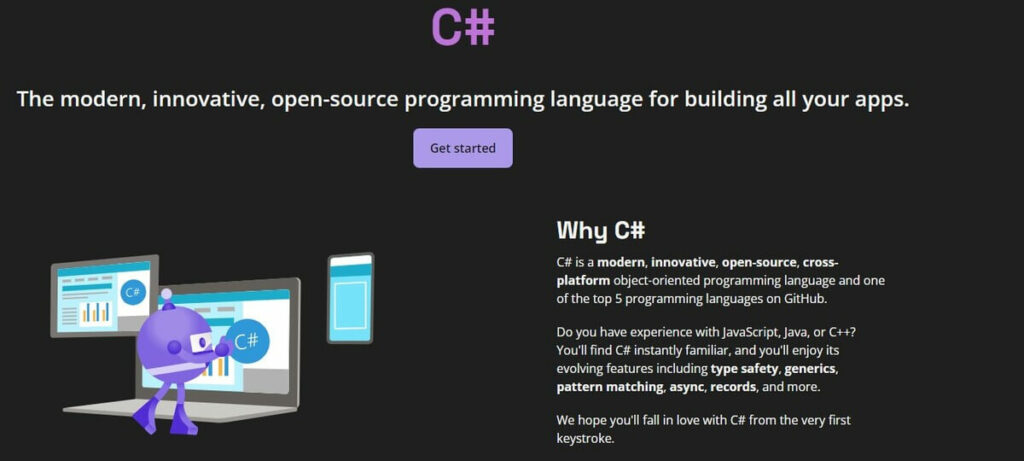
C# (pronounced “See Sharp”) is a modern, object-oriented, type-safe programming language. Microsoft created it, and it is primarily used on the Windows .NET framework for building desktop apps, web services, and other types of applications. C# is frequently used to develop applications that run on the .NET platform. It is a general-purpose language offering object-oriented programming and type safety features.
Key features and use cases
1. Object-Oriented Programming (OOP)
C# is an object-oriented language that supports encapsulation, inheritance, and polymorphism principles. This allows developers to create modular, reusable, and maintainable code.
2. Cross-Platform Development
With the introduction of .NET Core, C# can now be used for cross-platform development. This means you can write C# code and run it on different operating systems such as Windows, macOS, and Linux.
3. Rich Standard Library
Depending on your version, c # comes with a rich standard library, the .NET Framework or .NET Core. This library provides various functionalities and APIs for tasks such as file I/O, networking, database access, etc.
4. Asynchronous Programming
C# supports asynchronous programming through the use of async/await keywords. This allows developers to write code that can perform tasks concurrently, improving the performance and responsiveness of applications.
5. Windows Application Development
C# is commonly used for developing Windows desktop applications using frameworks like Windows Forms or Windows Presentation Foundation (WPF). These frameworks provide rich tools and controls for building user interfaces.
Advantages of C#
1. Object-Oriented Approach
C# is an object-oriented language allowing modular and organized code development. It supports concepts such as classes, objects, inheritance, and polymorphism, making it easier to manage complex projects.
2. Platform Compatibility
C# is primarily used on the .NET platform, which provides many libraries and frameworks for building applications. C# code can run on multiple platforms, including Windows, macOS, and Linux, making it a versatile choice for developers.
3. Productivity
C# offers a rich set of tools, libraries, and integrated development environments (IDEs) like Visual Studio, which enhance developer productivity. These tools provide features like code auto-completion, debugging capabilities, and powerful refactoring tools.
4. Performance
C# leverages the performance benefits of the .NET runtime, which includes features like just-in-time compilation and automatic memory management through garbage collection. This can result in efficient code execution and optimized memory usage.
Drawbacks of C#
1. Platform Dependency
Although C# can run on multiple platforms through .NET Core or Mono, it is primarily associated with the Windows ecosystem. This can limit its usage in certain environments where platform compatibility is a concern.
2. Learning Curve
C# has a moderate learning curve, especially for developers new to object-oriented programming. Understanding concepts like classes, objects, and inheritance might require some initial effort.
Real-World Examples and Applications of C#
1. Desktop Applications
C# is widely used for developing desktop applications, such as productivity tools, database management systems, and graphical user interfaces (GUIs). The Windows Presentation Foundation (WPF) framework, built on C#, enables developers to create visually appealing and interactive desktop applications.
2. Web Applications
C# is commonly used for building web applications using frameworks like ASP.NET and ASP.NET Core. These frameworks provide powerful features for creating dynamic websites, web services, and APIs.
3. Mobile App Development
C# can be used to develop mobile applications for iOS, Android, and Windows devices using frameworks like Xamarin. Xamarin allows developers to write shared code in C# and deploy it on multiple platforms, maximizing code reuse.
4. Game Development
C# is widely used in the game development industry. Popular game engines like Unity and Unreal Engine use C# as a scripting language, making it accessible for game developers to create interactive and immersive gaming experiences.
9. PHP

PHP is a popular server-side scripting language used for developing dynamic web applications. It was initially created in 1994 by Rasmus Lerdorf and has since become one of the most widely used programming languages for web development.
Key Features and Use Cases
1. Easy to Learn
PHP has a simple and intuitive syntax that makes it easy for beginners to pick up and start coding.
2. Web Development
PHP is primarily used for server-side web development. It can generate dynamic content, interact with databases, handle form submissions, and manage user sessions.
3. Open Source
PHP is open source, meaning it is freely available and has a large community of developers contributing to its development and providing support.
4. Cross-Platform Compatibility
PHP runs on various operating systems like Windows, macOS, and Linux and can be used with different web servers such as Apache and Nginx.
5. Database Integration
PHP has built-in support for various databases, including MySQL, PostgreSQL, and SQLite, allowing developers to interact with databases in their web applications easily.
6. Scalability
PHP is known for its ability to handle high traffic and scale well, making it suitable for large-scale web applications.
Advantages of PHP
1. Wide Adoption
PHP is widely adopted and has a large community of developers, making it easier to find resources, libraries, and frameworks for development.
2. Fast Development
PHP provides tools and libraries that simplify and speed up the development process, allowing developers to build web applications quickly.
3. Integration
PHP can easily integrate with other technologies such as HTML, CSS, JavaScript, and databases.
4. Cost-Effective
Since PHP is open source, it does not require any licensing fees, making it a cost-effective choice for web development.
Drawbacks of PHP
1. Inconsistent Language Design
PHP has a long history, and its evolution has resulted in inconsistencies and quirks in the language design.
2. Security
PHP has had some security vulnerabilities in the past, but with proper security practices, these risks can be mitigated.
3. Performance
PHP’s interpreted nature can be slower compared to compiled languages. However, with optimizations and caching techniques, PHP performance can still be improved.
Real-World Examples and Applications
1. WordPress
WordPress, one of the most popular content management systems, is built using PHP. It powers millions of websites worldwide.
2. Facebook
Parts of Facebook’s backend are built using PHP, demonstrating its scalability and ability to handle large user bases.
3. E-commerce Platforms
Many e-commerce platforms like Magento and WooCommerce.
10. Kotlin
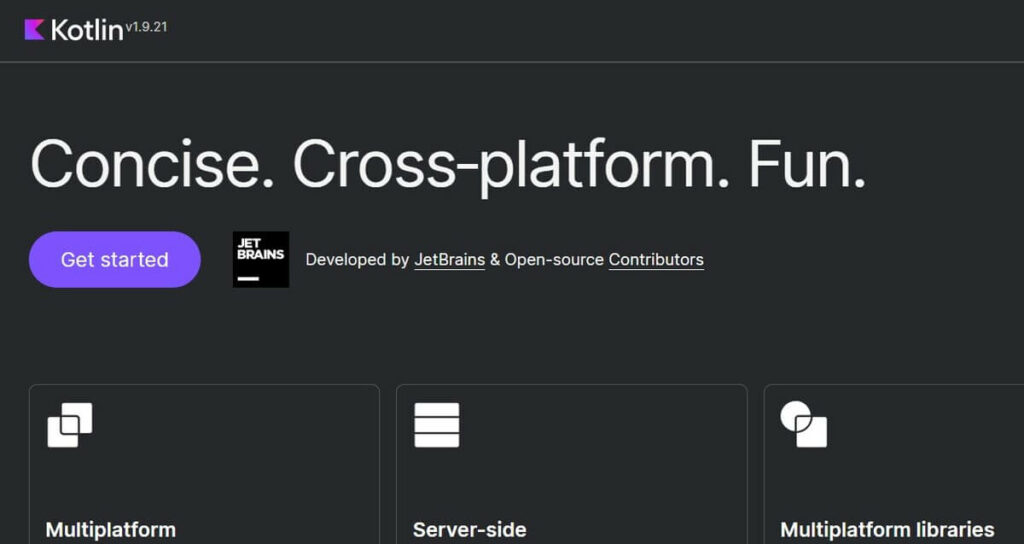
Kotlin is a modern programming language developed by JetBrains, initially targeting the Java Virtual Machine (JVM) but also supporting other platforms such as Android and native applications. It is designed to be expressive, concise, and interoperable with existing Java codebases, making it a popular choice for Android app development.
Key features and use cases
1. Interoperability with Java
Kotlin is fully interoperable with Java, allowing developers to seamlessly integrate Kotlin code with existing Java codebases. This makes it a popular choice for Android app development, as it can be used alongside Java in Android projects.
2. Concise and expressive syntax
Kotlin has a concise and expressive syntax, which reduces boilerplate code and improves code readability. It supports features like type inference, null safety, and lambda expressions, making code more concise and expressive.
3. Null safety
Kotlin has built-in null safety features, which help avoid null pointer exceptions at compile time. It provides a type system that distinguishes nullable and non-nullable types, reducing the risk of null-related bugs.
4. Coroutines
Kotlin has built-in support for coroutines, which are lightweight threads used for asynchronous programming. Coroutines simplify the handling of asynchronous operations and make concurrent programming more manageable.
5. Functional programming support
Kotlin supports functional programming paradigms, such as higher-order functions, lambda expressions, and immutable data structures. This allows developers to write clean and concise functional-style code.
Advantages of Kotlin
1. Improved productivity
Kotlin’s concise syntax and features like type inference and null safety help developers write code faster and with fewer errors. It enhances developer productivity and reduces development time.
2. Interoperability with Java
Kotlin’s seamless interoperability with Java allows developers to leverage existing Java libraries and frameworks. It makes migration from Java to Kotlin easier and enables mixed-language development.
3. Enhanced code readability
Kotlin’s expressive syntax and features like extension functions and smart casts contribute to code readability. It leads to more maintainable and understandable codebases.
Drawbacks of Kotlin
1. Learning curve
While Kotlin shares similarities with Java, there is still a learning curve for developers transitioning from Java to Kotlin. Becoming familiar with Kotlin’s syntax and features may take some time.
2. Build time
Kotlin can have slightly longer build times than Java, especially in larger projects. However, the impact on build times is generally minimal and can be alleviated by optimizing build configurations.
Real-world examples of Kotlin’s applications include
1. Android app development
Kotlin is widely used for developing Android applications. It is Google’s preferred language for Android development and offers seamless interoperability with existing Java code.
2. Backend development
Kotlin can be used for server-side development and building backend systems. It provides frameworks like Ktor and Spring Boot that enable developers to create robust and scalable web applications.
3. Cross-platform development
Kotlin Multiplatform allows developers to write shared code that can be used across multiple platforms, including Android, iOS, web, and desktop. This enables efficient code sharing and reduces development time.
4. Data science and analytics
Kotlin is gaining popularity in the data science community. It offers libraries like KotlinDL for deep learning and KMath for mathematical computations, making it suitable for data analysis and machine learning tasks.
5. Command-line tools and scripting
Kotlin can be used to build command-line tools and scripts. Its concise syntax and strong type system make it a good choice for automating tasks and creating utility programs.
6. Game development
Kotlin and frameworks like LibKTX and Korge can be used for game development. It provides the necessary tools and libraries to create interactive and engaging games.
7. IoT (Internet of Things) applications
Kotlin’s lightweight nature and support for low-level programming make it suitable for IoT applications. It can be used to develop firmware, control systems, and IoT devices.
8. Blockchain development
Kotlin can be used for blockchain development, including smart contract development on platforms like Ethereum. Its expressive syntax and type safety contribute to secure and reliable blockchain applications.
9. Web development
Kotlin can be used for building web applications and APIs. It offers frameworks like Ktor and Spring Boot that allow developers to create scalable, high-performance web services.
10. Desktop application development
Kotlin can be used to create desktop applications using frameworks like TornadoFX and JavaFX. It provides a modern and expressive language for building user-friendly desktop applications.
11. R

R is a programming language widely used for statistical computing and data analysis. Ross Ihaka and Robert Gentleman created it at the University of Auckland, New Zealand. R provides a wide range of statistical and graphical techniques and is highly extensible through its package ecosystem.
Key features and use case
1. Data Manipulation
R has powerful tools for data manipulation, transformation, and aggregation. It provides functions and operators that simplify cleaning, subsets, merging, and reshaping data.
2. Statistical Analysis
R has a comprehensive set of statistical functions and libraries, enabling users to perform various statistical analyses. It supports various statistical tests, regression models, and time series analysis.
3. Data Visualization
R offers a wide range of graphical capabilities for creating high-quality visualizations. It has libraries like ggplot2, allowing users to create customized and visually appealing plots, charts, and graphs.
4. Reproducible Research
R provides tools and workflows that support reproducible research. Users can document their code and analysis steps, making it easier to reproduce results and share their work with others.
Advantages of R
1. Rich Package Ecosystem
R has a vast collection of packages the community contributes, providing additional functionality and making it easy to perform specialized tasks.
2. Open Source
R is an open-source, freely available language with a large and active user community.
3. Integration with Other Languages
R can be easily integrated with other programming languages like Python, Java, and C++, allowing users to leverage the strengths of different languages in their projects.
Drawbacks of R
1. Steep Learning Curve
R has a steep learning curve, especially for users new to programming or statistical analysis. The syntax and concepts can be challenging initially.
2. Memory Usage
R can be memory-intensive, especially when dealing with large datasets. Users need to be mindful of memory limitations and optimize their code accordingly.
Real-world examples and applications of R
1. Data Analysis and Visualization
R is commonly used for data analysis and visualization tasks. It helps analysts and data scientists explore, clean, manipulate, and visualize data to gain insights and make data-driven decisions. Companies like Google, Facebook, and Airbnb use R to analyze user data to improve their products and services.
2. Statistical Modeling
R has extensive libraries and packages for statistical modeling, making it a popular choice for researchers and statisticians. It is used in fields such as finance, healthcare, social sciences, and market research to perform regression analysis, hypothesis testing, survival analysis, and more. Pharmaceutical companies use R for drug development and clinical trials.
3. Machine Learning
R provides powerful libraries like “caret” and “mlr” for machine learning tasks. It is used for building predictive models, classification, clustering, and recommendation systems. E-commerce, finance, and healthcare companies use R for fraud detection, customer segmentation, and personalized recommendations.
4. Time Series Analysis
R has specialized packages like “forecast” and “xts” for analyzing time series data. It is widely used in finance and economics for forecasting stock prices, sales, and economic indicators. Weather forecasting agencies also use R for analyzing and predicting weather patterns.
5. Bioinformatics
R is extensively used in bioinformatics for analyzing and visualizing genomic and proteomic data. It helps researchers in genomics, molecular biology, and genetics to analyze DNA sequencing data, identify patterns, and discover gene functions.
6. Academic Research
R is widely used in academic research across various disciplines. Researchers and scholars use R for data analysis, statistical modeling, and generating visualizations to support their research findings.
12. Rust

Rust is a modern programming language that combines the performance of low-level languages like C and C++ with the safety and expressiveness of high-level languages.
Key features and use cases
1. Memory safety
Rust’s ownership system ensures memory safety by enforcing strict rules at compile-time, preventing common programming errors such as null pointer dereferences, buffer overflows, and data races.
2. Concurrency
Rust’s design encourages safe concurrent programming by eliminating data races through its ownership and borrowing system. It provides powerful abstractions for concurrent programming, such as threads and asynchronous programming models.
3. Performance
Rust is designed for high-performance applications. It provides low-level control over system resources, allowing developers to write safe and efficient code.
4. Cross-platform
Rust supports multiple platforms, including Windows, macOS, Linux, and embedded systems. It can be used to develop applications ranging from desktop software to embedded systems and IoT devices.
5. Web development
Rust can be used for web development on the server and client sides. It offers frameworks like Rocket and Actix-Web for building fast and scalable web applications.
6. Systems Programming
Rust is particularly well-suited for systems programming tasks, such as writing operating systems, device drivers, and embedded systems. Its low-level control and memory safety features make it a reliable choice for such applications.
Advantages of Rust
1. Memory and thread safety features reduce the likelihood of bugs and crashes.
2. High performance and low-level control over system resources.
3. Strong community support and active ecosystem.
4. Easy integration with existing C/C++ codebases.
5. Cross-platform support.
Drawbacks of rust
1. Steep learning curve due to its unique ownership and borrowing system.
2. Limited libraries and frameworks compared to more established languages.
3. Longer compilation times compared to languages like C or C++.
4. Less mature tooling and libraries in certain domains.
Real-world examples of applications built with Rust include
1. Web development
Rust is increasingly used for web development, with frameworks like Rocket and Actix providing efficient and secure solutions for building web applications.
2. Systems Programming
Rust’s memory safety guarantees make it well-suited for systems programming tasks, such as building operating systems, device drivers, and embedded systems.
3. Networking
Rust’s low-level control and concurrency features make it a good choice for networking applications, including building servers, proxies, and network protocols.
4. Game development
Rust’s performance and memory safety features make it suitable for game development, with libraries like Amethyst providing game engine frameworks and tools.
5. Blockchain and cryptocurrency
Rust is gaining popularity in the blockchain and cryptocurrency space due to its emphasis on security and performance. Projects like Parity Ethereum and Solana are built with Rust.
6. Command-line tools
Rust’s ease of use and cross-platform support make it a great choice for building command-line tools and utilities, enabling developers to create efficient and reliable command-line interfaces.
13. Perl

Perl is a high-level, general-purpose programming language initially developed for text manipulation tasks but has since evolved into a versatile language used in various applications. It combines features from various programming paradigms, including procedural, object-oriented, and functional programming.
Key Features and Use Cases
1. Database Integration
Perl provides seamless integration with various databases, including Oracle, Sybase, Postgres, MySQL, and more, through its popular DBI interface. This allows developers to connect, query, and manipulate data in different database systems.
2. Text Manipulation
Perl is renowned for its powerful text-processing capabilities. It offers a rich set of built-in functions and supports regular expressions, making it ideal for data extraction, transformation, and pattern-matching tasks.
3. Web Development
Perl is extensively used in web development, particularly for backend programming. It can handle tasks such as handling HTTP requests, generating dynamic web pages, interacting with databases, and developing web-based APIs.
4. Scripting and Automation
Perl’s flexibility and ease of use make it popular for scripting and automation tasks. It can be used to write scripts for various purposes, such as file manipulation, system administration, log analysis, and automation of repetitive tasks.
5. System Utilities
Perl is often utilized for developing system utilities and command-line tools. Its ability to interact with the operating system, file handling capabilities, and text-processing features make it suitable for system management and automation tasks.
Advantages of Perl
1. Versatility
Perl incorporates features from various languages, making it a versatile and flexible programming language.
2. Database integration
Perl has a robust database integration interface (DBI), allowing seamless integration with popular databases like Oracle, Sybase, Postgres, and MySQL.
3. Object-oriented programming
Perl supports object-oriented programming, offering a simple and intuitive syntax for creating and working with objects.
4. Text manipulation capabilities
Perl is renowned for its powerful text processing capabilities, including regular expression support and built-in functions for efficient string manipulation.
5. Web development
Perl is extensively used in web development, excelling in tasks like data wrangling, text manipulation, and backend programming.
Drawbacks of Perl
1. High resource usage
Perl tends to require high CPU and memory usage, which can hinder running Perl programs on systems with limited resources.
2. Readability concerns
Perl code can be untidy and unreadable, leading to potential difficulties in maintaining and understanding the codebase.
Real-world examples and applications of Perl
1. CGI scripts
Perl is widely used for creating CGI scripts, enabling dynamic content generation on web servers.
2. Log analysis
Perl is commonly utilized for log analysis tasks, extracting and processing data from log files.
3. Database management
Perl’s database integration capabilities make it suitable for managing and manipulating data in various database systems.
4. Text processing and data wrangling
Perl’s text manipulation capabilities make it ideal for data extraction, transformation, and analysis tasks.
5. Automation and scripting
Perl’s scripting capabilities make it popular for automating repetitive tasks and creating system administration scripts.
14. TypeScript

TypeScript is a programming language that is a superset of JavaScript, meaning it builds upon the existing JavaScript language.
It introduces static typing to JavaScript, allowing developers to catch errors during development rather than at runtime.
TypeScript code is transpiled into JavaScript, making it compatible with all JavaScript environments.
Key Features and Use Cases
1. Static Typing
TypeScript introduces static types, allowing developers to define the types of variables, function parameters, and return values. This helps catch errors early and provides better tooling support.
2. Object-Oriented Programming (OOP) Support
TypeScript supports features like classes, interfaces, inheritance, and modules, making it suitable for building large-scale applications following OOP principles.
3. Advanced JavaScript Features
TypeScript supports the latest ECMAScript (ES) features and allows developers to use them even in environments that don’t fully support them yet.
4. Tooling and Editor Support
Thanks to its strong type system, TypeScript provides a rich development experience with features like code navigation, autocompletion, refactoring, and static code analysis.
5. Compatibility with JavaScript Ecosystem
TypeScript can be gradually adopted in existing JavaScript projects, allowing developers to leverage existing libraries and frameworks.
Advantages of TypeScript
1. Enhanced Code Quality
TypeScript’s static typing helps catch type-related errors during development, reducing bugs and improving code quality.
2. Improved Developer Productivity
TypeScript’s tooling, editor support, code navigation, and auto-completion features enhance developer productivity.
3. Better Code Maintainability
TypeScript’s support for OOP principles and advanced features allows for cleaner, modular, and maintainable codebases.
Drawbacks of TypeScript
1. Learning Curve
Developers familiar with JavaScript may need to invest time in understanding and adapting to TypeScript’s type system and additional features.
2. Build Process
As TypeScript code needs to be transpiled into JavaScript, an additional build step is required, which may increase the overall build time.
Real-world examples and applications
1. Angular
TypeScript is the recommended language for building Angular applications, a popular front-end framework.
2. React
TypeScript can be used in conjunction with React to build scalable and type-safe applications.
3. Node.js
TypeScript is widely adopted in Node.js projects, providing static typing and advanced JavaScript features for server-side development.
4. Microsoft Office
Microsoft has used TypeScript to build various components of the Microsoft Office suite, including Outlook and Office.
15. SQL
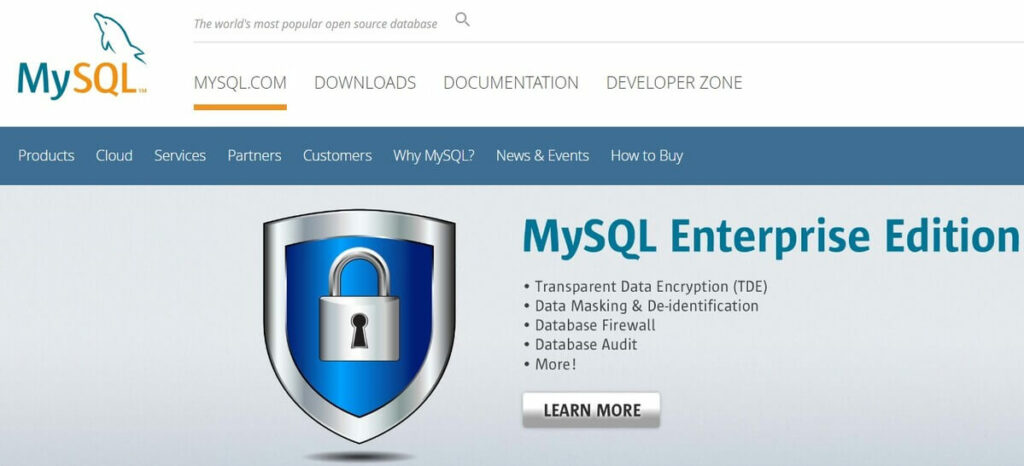
SQL, which stands for Structured Query Language, is a standard programming language for managing and manipulating relational databases. It provides a set of commands and syntax for querying, updating, and managing data stored in a relational database management system (RDBMS).
Key features and use cases
1. Declarative language
SQL is a declarative language, meaning that users can specify what data they want to retrieve or manipulate without having to specify how to do it. This makes SQL easy to use and understand.
2. Data manipulation
SQL is primarily used for managing and manipulating data in relational databases. It provides commands such as SELECT, INSERT, UPDATE, and DELETE to retrieve, insert, modify, and delete data from tables.
3. Data definition
SQL also allows users to define the data structure in a database. It provides commands such as CREATE TABLE, ALTER TABLE, and DROP TABLE to create, modify, and delete database tables, columns, and constraints.
4. Querying and joining data
SQL supports powerful querying capabilities, allowing users to retrieve data from one or more tables using various conditions and operators. It also supports joining tables based on common columns to combine related data.
5. Data integrity and constraints
SQL provides features to enforce data integrity in databases, such as defining primary keys, unique constraints, and foreign key relationships. These constraints help maintain data consistency and prevent data corruption.
6. Aggregation and grouping
SQL supports functions for aggregating data, such as SUM, COUNT, AVG, MIN, and MAX, and the ability to group data based on certain criteria. This allows users to perform calculations and analyze data at different levels of granularity.
7. Transactions and concurrency control
SQL supports transactions, allowing users to group multiple database operations into atomic work units. It also provides mechanisms for managing concurrency control, ensuring multiple users can access and modify the same data without conflicts.
8. Stored procedures and functions
SQL allows users to define and execute stored procedures and functions, which are reusable blocks of code that can perform complex operations on the database. This helps improve code organization and reusability.
Advantages of SQL
1. Easy to learn and use
SQL has a simple and intuitive syntax, making it relatively easy for users to understand and write queries.
2. Standardized language
SQL is a standardized language, meaning that it is supported by various database management systems (DBMS) and can be used across different platforms.
3. Efficient and optimized
DBMSs often optimize SQL queries for efficient data retrieval and manipulation, allowing for high-performance database operations.
Drawbacks of SQL
1. Complexity
SQL can be complex to learn and use, especially for beginners. It requires understanding the relational model, SQL syntax, and query optimization techniques.
2. Lack of standardization
While SQL is a standard language for relational databases, different database management systems (DBMS) may vary their SQL implementations. This can lead to portability and compatibility issues when switching between different DBMSs.
3. Performance limitations
In certain cases, SQL queries can be slow and inefficient, especially when dealing with large datasets or complex joins. Query optimization techniques are required to improve performance, but it can be challenging to write efficient queries.
4. Limited support for non-relational data structures
SQL is primarily designed for relational databases and may not be the best choice for handling non-relational data structures, such as hierarchical or graph-based data.
5. Lack of procedural capabilities
SQL is primarily a declarative language for querying and manipulating data. While it does provide some procedural constructs, it may not be suitable for complex procedural logic or algorithmic programming tasks.
6. Security vulnerabilities
SQL can be susceptible to security vulnerabilities such as SQL injection attacks, where malicious code is injected into SQL statements. Proper input validation and parameterization techniques are required to mitigate these risks.
Real-world examples and applications
1. Data management
SQL is widely used for storing, retrieving, and manipulating data in relational databases. It is used in various industries for managing data in applications such as customer relationship management (CRM), enterprise resource planning (ERP), and content management systems (CMS).
2. Business intelligence and analytics
SQL is a key tool for performing data analysis and generating insights. It is used for tasks such as aggregating data, creating reports, and performing complex analytical queries.
3. E-commerce and online transactions
SQL is used for managing online stores and processing transactions. It is used to store product information, handle inventory management, and process payment transactions.
4. Web development
SQL is used in conjunction with web development frameworks to store and retrieve data from databases. It is used for tasks such as user authentication, content management, and storing user-generated data.
5. Data warehousing
SQL is used for building and managing data warehouses, which are large structured and historical data repositories. It is used for data extraction, transformation, and loading (ETL) processes to populate and maintain data warehouses.
16. MATLAB
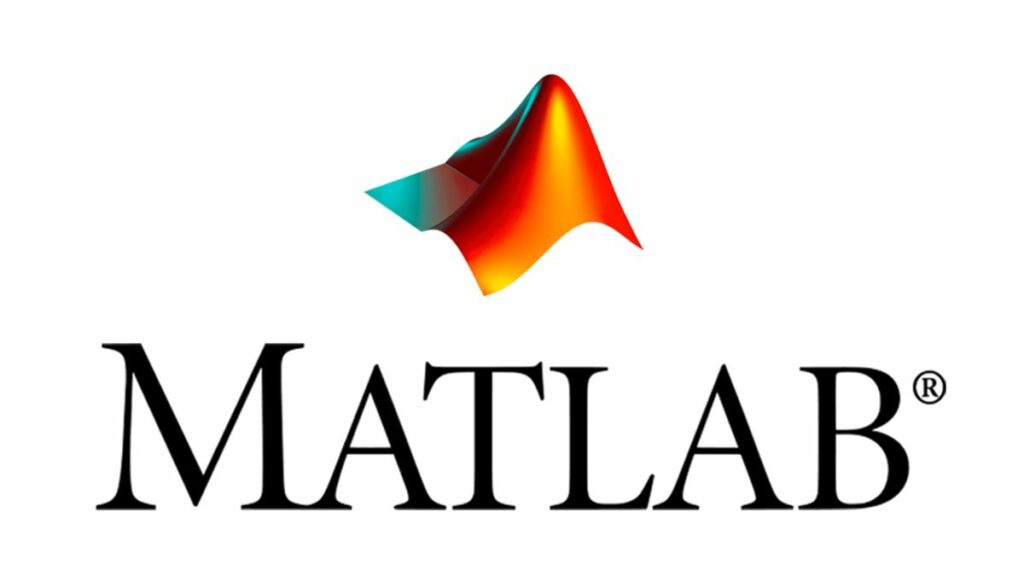
MATLAB is a high-level programming language and environment commonly used in scientific and engineering applications. It provides a flexible and powerful platform for numerical computation, data analysis, visualization, and algorithm development.
Key Features and Use Cases
1. Mathematical Computing
MATLAB offers a vast collection of built-in mathematical functions and libraries, making it ideal for tasks such as linear algebra, optimization, statistics, and signal processing.
2. Data Analysis and Visualization
MATLAB provides extensive tools for importing, manipulating, and analyzing data and creating high-quality visualizations, plots, and graphs.
3. Algorithm Development
MATLAB’s ease of use and extensive library of prebuilt functions make it a popular choice for developing and testing algorithms. It supports rapid prototyping and enables the implementation of complex algorithms in a short amount of time.
4. Simulations and Modeling
MATLAB supports creating mathematical models and simulations for various applications, including physics, biology, finance, and control systems.
Advantages of MATLAB
Its intuitive syntax, rich mathematical functionality, and extensive library ecosystem. It also provides excellent documentation and a large online community for support.
Drawbacks of MATLAB
It can be computationally expensive for large-scale problems, and the licensing cost can be high for commercial use. Additionally, it is not a general-purpose language and may not be the most efficient choice for certain tasks.
Real-World Examples and Applications
MATLAB is widely used in various industries and research fields. Some examples of its applications include:
1. Data Analysis and Visualization
MATLAB is used for analyzing and visualizing large datasets in fields such as finance, climate science, and bioinformatics.
2. Control Systems and Robotics
MATLAB is used for modeling, simulation, and control design in aerospace, automotive, and robotics industries.
3. Image and Signal Processing
MATLAB is utilized for tasks such as image and video processing, speech recognition, and audio signal analysis.
4. Machine Learning and Artificial Intelligence
MATLAB provides tools and libraries for developing and implementing machine learning algorithms and AI models.
Recommended Article: Best Laptops for MATLAB
17. Shell scripting languages

Shell scripting languages, such as Bash, are powerful tools that allow users to automate tasks and streamline workflows in a command-line environment.
Key Features and Use Cases
1. Interpreted Execution
Shell scripting languages are interpreted, allowing for quick development and immediate execution without the need for compilation. They are ideal for automating repetitive tasks and system administration.
2. Built-in Commands
Shell scripting languages provide built-in commands and utilities for file manipulation, text processing, and system management. They can handle file management, string manipulation, process control, and more tasks.
3. Command-line Interface
Shell scripting languages are primarily used through a command-line interface, making them suitable for automating tasks and executing multiple commands efficiently. They excel at automating system administration tasks.
4. Variables and Control Flow
Shell scripting languages support variables and offer control flow constructs like loops and conditional statements. This enables developers to create dynamic scripts that adapt to different scenarios based on specific conditions.
Advantages of Shell scripting
1. Accessibility
Shell scripting languages have a low entry barrier, making them accessible even for users with limited programming experience. They have a simple syntax and a large community of users providing support and resources.
2. Rapid Development
Shell scripting languages are known for their quick prototyping and development cycles. They allow for the rapid development of small-scale applications and the automation of repetitive tasks.
3. Portability
Shell scripting languages are highly portable across different operating systems. They are supported on various Unix-like systems, making deploying and running scripts on different machines easier without significant modifications.
Drawbacks of Shell scripting
1. Performance
Shell scripting languages are interpreted, which can result in slower execution compared to compiled languages. They may not be suitable for computationally intensive tasks that require high performance.
2. Limited Data Structures
Shell scripting languages have limited support for advanced data structures like arrays or dictionaries. More complex data manipulation may require integration with other programming languages.
Real-World Examples and Applications
1. System Administration
Shell scripting languages are extensively used in system administration tasks, such as configuring servers, managing users and permissions, and automating backups and monitoring.
2. Deployment Automation
Shell scripts are commonly used for automating application deployment processes, including installation, dependency management, and configuration setup.
3. Data Processing and Analysis
Shell scripting languages offer powerful text processing capabilities, making them useful for data manipulation and analysis.
18. Dart

Dart is a programming language developed by Google that is primarily used for building web and mobile applications. It is designed to be easy to learn and efficient to run, making it a popular choice among developers.
Key Features and Use Cases
1. Object-oriented
Dart is an object-oriented language that allows developers to organize their code into classes and objects for better code organization and reusability.
2. Strong typing
Dart supports static typing, which helps catch errors during compilation and improves code reliability and maintainability.
3. Asynchronous programming
Dart provides built-in support for asynchronous programming, making it easy to handle tasks like I/O operations and network requests without blocking the execution of other code.
4. Flutter framework
Dart is the primary language used for developing applications using the Flutter framework, which allows for cross-platform development of mobile, web, and desktop applications.
Advantages of Dart
1. Easy to learn
Dart has a clean and intuitive syntax, making it relatively easy for developers to learn and start building applications.
2. High performance
Dart’s Just-in-Time (JIT) compilation and Ahead-of-Time (AOT) compilation options allow for fast and efficient execution of code, resulting in high-performance applications.
3. Strong tooling
Dart comes with a rich set of tools, including the Dart SDK, IDE plugins, and debugging support, contributing to a smooth development experience.
4. Cross-platform development
Dart’s integration with the Flutter framework enables developers to build applications for multiple platforms using a single codebase, including iOS, Android, and the web.
Drawbacks of Dart
1. Limited ecosystem
While Dart’s ecosystem is growing, it is still relatively smaller than more established languages like JavaScript or Python. This may result in fewer libraries and community support for certain use cases.
2. Learning curve for Flutter
Although Dart is easy to learn, using it with the Flutter framework may have a learning curve, especially for developers new to mobile app development.
Real-World Examples and Applications:
1. Google Ads
Dart is used to develop Google Ads, one of the largest advertising platforms in the world. Dart’s performance and cross-platform capabilities make it suitable for building complex applications like ad management systems.
2. Flutter apps
Many popular mobile applications, such as the Google Ads app, Alibaba, and Reflectly, are built using Dart and the Flutter framework. Dart’s ability to create visually appealing and performant user interfaces.
19. Scala
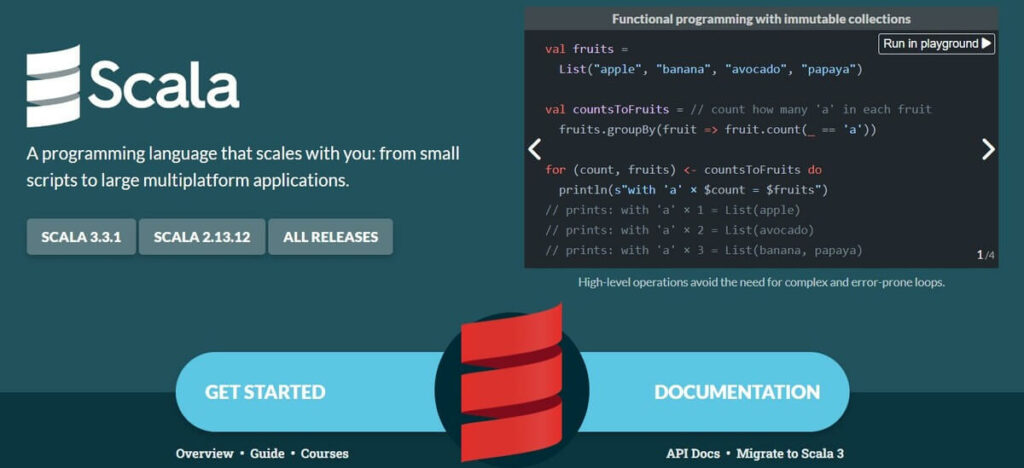
Scala is a general-purpose programming language that combines object-oriented and functional programming paradigms. It is designed to be concise, expressive, and scalable, making it suitable for a wide range of applications.
Key Features and Use Cases
1. Object-Oriented and Functional Programming
Scala supports both object-oriented and functional programming styles. It allows developers to mix imperative and functional code seamlessly, providing flexibility and expressiveness in solving complex problems.
2. JVM Compatibility
Scala runs on the Java Virtual Machine (JVM), which allows it to interoperate with existing Java libraries and frameworks. This compatibility makes it popular for building robust and scalable applications in finance, e-commerce, and data analysis industries.
3. Static Typing and Type Inference
Scala is statically typed, which helps catch errors at compile time and improves code reliability. It also features powerful type inference, reducing the need for explicit type annotations and making the code more concise.
4. Concurrency and Parallelism
Scala provides built-in support for concurrent and parallel programming. It offers features like actors and futures, simplifying the development of concurrent applications and enabling efficient utilization of multi-core processors.
Advantages of Scala
1. Expressive and Concise
Scala’s concise syntax and expressive features allow for more readable and maintainable code, reducing development time and improving overall productivity.
2. Scalability
Scala’s support for functional programming and its ability to leverage the JVM’s concurrency features make it suitable for building scalable, high-performance applications.
3. Interoperability
Scala seamlessly integrates with Java, enabling developers to leverage existing Java libraries and frameworks, reuse code, and take advantage of the extensive Java ecosystem.
Drawbacks of Scala
1. Learning Curve
Scala has a steep learning curve, especially for developers coming from a purely object-oriented programming background. Its powerful features and rich syntax may require time to grasp and utilize effectively and fully.
2. Compilation Time
Scala’s compilation process can be slower than other languages, impacting larger projects’ development cycle and turnaround time.
3. Tooling and Community
Although Scala has a growing community and a range of available tools, it may not have the same level of maturity and extensive tooling ecosystem as some other programming languages.
Real-World Examples and Applications
1. Big Data Processing
Scala is widely used in big data frameworks like Apache Spark. Its scalability, functional programming support, and seamless integration with Spark make it a popular choice.
20. Lua

Lua is a lightweight, powerful, and embeddable scripting language that is primarily used for extending applications, scripting, and rapid prototyping.
Key Features and Use Cases
1. Simple and Lightweight
Lua has a minimalistic design with a simple syntax, making it easy to learn and use. It is a lightweight language that can be easily embedded into existing applications.
2. Embeddable
Lua is designed to be embedded in applications as a scripting language, providing high customization and extensibility. It can seamlessly integrate with C/C++ code, making it ideal for game development, application scripting, and plugin systems.
3. Fast and Efficient
Lua offers excellent performance due to its just-in-time (JIT) compilation capabilities. It has a small memory footprint and is optimized for speed, making it suitable for resource-constrained environments.
4. Dynamic Typing and Automatic Memory Management
Lua supports dynamic typing, allowing for flexible and dynamic programming. It also has automatic memory management, relieving developers from memory allocation and deallocation tasks.
Advantages of Lua
1. Easy to learn and use
Lua’s simplicity and clean syntax make it accessible to beginners and experienced programmers.
2. Extensibility
Lua can be easily integrated into existing applications, providing flexibility and customization options.
3. Fast and efficient
Lua’s JIT compilation and small memory footprint contribute to its high performance.
Drawbacks of Lua
1. Limited Standard Library
Lua has a minimal standard library compared to other scripting languages. However, this can be overcome by using external libraries and modules.
2. Less widespread adoption
While Lua is widely used in game development (e.g., in game engines like Unity and Corona SDK), it may not have the same level of popularity and community support as more mainstream scripting languages.
Real-World Examples and Applications
1. Game Development
Lua is extensively used in the game development industry. It is often used as a scripting language in game engines like Unity3D, allowing developers to create game logic and behaviors.
2. Embedded Systems
Due to its lightweight nature and small memory footprint, Lua is commonly used in embedded systems for tasks such as automation, control, and scripting interfaces.
3. Scripting and Rapid Prototyping
Lua’s simplicity and ease of use make it popular for scripting tasks and rapid prototyping. It is often used to create scripts for workflow automation, and configuration management.
21. Groovy

Groovy is a powerful programming language that runs on the Java Virtual Machine (JVM). It offers a variety of features and is widely used in the Java ecosystem.
Key Features and Use Cases
1. Object-Oriented
Groovy is a fully object-oriented language with features like classes, objects, and inheritance. It seamlessly integrates with Java, allowing developers to leverage existing Java libraries and frameworks.
2. Dynamic Typing
Groovy supports dynamic typing, meaning variable types are determined at runtime. This provides flexibility and allows for faster development by reducing the need for explicit type declarations.
3. Concise Syntax
Groovy has a concise and expressive syntax inspired by languages like Python and Ruby. It offers features like closures, optional parentheses, and enhanced collections, making code more readable and concise.
4. Domain-Specific Language (DSL) Support
Groovy has strong support for creating internal DSLs. This enables developers to write code that reads like a domain-specific language, making it easier to express complex business logic or configuration.
5. Metaprogramming
Groovy allows metaprogramming, meaning it can modify its structure or behavior at runtime. This feature enables advanced techniques like AST transformations and runtime method injection.
Advantages of Groovy
1. Seamless Java Integration
Groovy can use existing Java classes and libraries directly, making integrating with Java code and leveraging the vast Java ecosystem easy.
2. Rapid Development
Groovy’s concise syntax and dynamic typing enable developers to write code quickly and iterate faster during development.
3. Testing and Scripting
Groovy’s scripting capabilities make it suitable for writing scripts and running tests, allowing for efficient automation and easy scripting tasks.
Drawbacks of Groovy
1. Performance
Groovy’s dynamic typing and runtime dispatch can impact performance compared to statically typed languages like Java.
2. Learning Curve
While Groovy has similarities to Java, it also introduces new concepts and syntax. Developers familiar with Java may need time to learn and adjust to Groovy’s features and conventions.
Real-World Examples and Applications
1. Build Automation
Groovy is used extensively in building automation tools like Gradle. Gradle leverages Groovy’s DSL capabilities to define build scripts that are flexible and easy to understand.
2. Web Development
Groovy is used in web development.
What are the benefits of learning a programming language?
Learning a programming language offers numerous benefits that greatly enhance one’s skills and opportunities in various fields. Some of the key benefits include:
1. Problem-solving skills
Programming requires logical thinking and breaking down complex problems into smaller, manageable fragments. Learning a programming language can help develop critical thinking and problem-solving skills applicable to many life areas.
2. Career opportunities
With the growing demand for technology, learning a programming language opens up many career opportunities. From software development to data analysis, web development to artificial intelligence, programming skills are highly aspired in today’s job market.
3. Creativity and innovation
Programming allows individuals to bring their ideas to life by creating software, websites, or applications. It encourages creativity and empowers individuals to build innovative solutions to real-world problems.
4. Improved analytical skills
Programming involves analyzing data, identifying patterns, and developing algorithms. By learning a programming language, individuals can enhance their analytical abilities and apply them to various domains, such as data science, finance, or research.
5. Automation and efficiency
With programming knowledge, individuals can automate repetitive tasks and streamline processes, increasing efficiency and productivity. This skill is particularly beneficial in business, administration, and project management.
What are the challenges of learning a programming language?
Learning a programming language can come with its fair share of challenges. Some common difficulties that individuals may encounter include:
1. Hard to Learn
Programming languages often have complex syntax and concepts that can overwhelm beginners. Understanding the fundamentals and grasping the logic behind programming can take time and effort.
2. Technical jargon
Programming languages have their terminology and acronyms, which can confuse beginners. Learning and understanding these technical terms is a challenge in itself.
3. Debugging and troubleshooting
Programming involves identifying and fixing errors in code. Debugging can be a challenging and time-consuming process, requiring patience and problem-solving skills.
4. Complexity and abstraction
As individuals progress in learning a programming language, they encounter more advanced concepts and abstractions. Understanding these higher-level concepts and applying them effectively can be challenging.
5. Keeping up with advancements
Programming languages and frameworks evolve rapidly. Staying updated with the latest trends and technologies can be challenging, requiring continuous learning and adaptation.
Trends in programming language popularity
Trends in programming language popularity can vary over time as new languages emerge and existing languages evolve. It is important to note that popularity can be measured based on various metrics, such as job postings, community engagement, or usage within specific industries.
Some general trends in programming language popularity include:
1. Python
Python has consistently grown in popularity due to its versatility and ease of use. It is widely used in data analysis, machine learning, web development, and scientific computing.
2. JavaScript
JavaScript remains one of the most popular languages for web development, powering interactive and dynamic websites. Its frameworks like React and Angular, have contributed to its continued growth.
3. Java
Java has been a popular choice for enterprise-level applications, Android app development, and back-end systems. Its long-standing presence and robust ecosystem contribute to its popularity.
4. C and C++
C and C++ have been widely used for system-level programming, operating systems, game development, and embedded systems. Their performance and low-level capabilities continue to make them popular choices.
5. Swift
Swift is the language many use to make apps for iPhones and Mac computers. People like it because it’s modern, safe, and works well with older Objective-C code.
6. Go
Go, also known as Golang, has gained popularity for its simplicity, concurrency support, and efficiency. It is commonly used for cloud services, networking, and distributed systems.
7. Rust
Rust has gained popularity for its focus on safety, memory management, and performance. It is often used for system-level programming, web servers, and embedded systems.
8. TypeScript
TypeScript, a statically typed superset of JavaScript, has gained popularity for its ability to improve JavaScript codebase maintainability and scalability. It is widely used in large-scale web applications.
9. Kotlin
Kotlin has gained popularity as an alternative to Java for Android app development. Its concise syntax, null safety, and compatibility with existing Java codebases have contributed to its growth.
10. R
R is widely used in data science and statistical computing. Its extensive library ecosystem and built-in statistical functions make it popular for data analysis and visualization tasks.
Factors to consider when choosing a programming language
When choosing a programming language, there are several factors to consider:
1. Purpose and Project Requirements
Consider the specific purpose of your project and the requirements it entails. Different programming languages are better suited for different types of applications.
For example, languages like JavaScript, Python, or Ruby may be more appropriate for developing a web application. C or C++ might be better if you’re working on embedded systems.
2. Learning Curve and Familiarity
Consider your level of experience and familiarity with programming languages.
- If you’re a beginner, choose a language with a gentle learning curve and a large community for support.
- For more experienced developers, explore languages that offer more advanced features and performance optimizations.
3. Community and Support
Look into the programming language’s community and support ecosystem. A strong community can provide valuable resources, documentation, libraries, frameworks, and forums for troubleshooting. It can also indicate the longevity and popularity of the language.
4. Performance and Efficiency
If your application requires high-performance computing or low-level hardware interaction, consider languages like C or C++, which provide better control over system resources. However, if performance is not a crucial factor, languages like Python or Ruby offer better productivity and ease of development.
5. Scalability
Consider the scalability of the language for your project. Some languages are better suited for small-scale projects, while others excel in handling large-scale systems. Factors to consider include the language’s support for concurrent programming, distributed systems, and scalability frameworks or libraries.
6. Integration and Compatibility
If you need to integrate your application with existing systems or third-party services, consider the compatibility of the language with those systems. Some languages have robust libraries and APIs that simplify integration with common technologies and platforms.
7. Job Market and Future Career Prospects
Consider the demand for developers skilled in the chosen language. Certain languages may have a larger job market and more opportunities for career growth. Research industry trends and assess the prospects of the language you’re considering.
Recommended Article: Best Laptops for Freelancers and Online Jobs
Recommended resources for learning programming languages
There are numerous resources available for learning programming languages.
1. Online tutorials and courses
- Codecademy: Offers interactive coding lessons for various programming languages.
- Udemy: Provides a wide range of programming courses taught by industry experts.
- Coursera: Offers programming courses from top universities and institutions.
- FreeCodeCamp: Provides free interactive coding challenges and projects.
2. Books
- “Python Crash Course” by Eric Matthes: A beginner-friendly book for learning Python.
- “JavaScript: The Good Parts” by Douglas Crockford: Covers the essentials of JavaScript.
- “Eloquent JavaScript” by Marijn Haverbeke: A comprehensive guide to JavaScript.
3. Documentation and official websites
- For Python: Python’s official documentation is a valuable resource (docs.python.org).
- For JavaScript: The Mozilla Developer Network (MDN) provides comprehensive documentation (developer.mozilla.org).
4. Online coding platforms:
- HackerRank: Offers coding challenges and competitions to practice programming skills.
- LeetCode: Provides coding problems to improve coding abilities.
- Codewars: Allows users to practice coding skills by solving challenges and participating in kata.
5. Video tutorials and YouTube channels
- TheNewBoston: Offers a wide range of programming tutorials on YouTube.
- Traversy Media: Provides tutorials on web development and programming languages.
- Corey Schafer: Offers in-depth tutorials on Python and web development.
6. Online coding communities:
- Stack Overflow: A question-and-answer community for programming-related queries.
- GitHub: A platform for collaborating on coding projects and exploring open-source code.
Recommended Article: Best Laptops for Computer Science Students
Career opportunities for programmers
Career opportunities for programmers are abundant and diverse.
1. Software Developer/Engineer
Software developers design, develop, and maintain computer software applications. They often work with programming languages like Java, Python, C++, or JavaScript to create programs and systems.
2. Web Developer
Web developers specialize in building and maintaining websites. They use programming languages like HTML, CSS, and JavaScript to create user-friendly and visually appealing websites.
3. Data Analyst
Data analysts gather, analyze, and interpret large data sets to help organizations make informed business decisions. They use programming languages like Python or R to process data and apply statistical analysis.
4. Mobile App Developer
Mobile app developers create applications for smartphones and tablets. They may work with programming languages such as Swift (for iOS) or Java/Kotlin (for Android).
5. Game Developer
Game developers design and create video games. They use programming languages like C++ or C# to develop game mechanics, graphics, and interactive features.
6. Systems Analyst
Systems analysts evaluate and improve computer systems for organizations. They analyze requirements, design solutions, and implement software using programming languages and tools.
7. Cybersecurity Analyst
Cybersecurity analysts protect computer systems and networks from potential security threats. They use programming languages and tools to identify vulnerabilities and develop security measures.
Recommended Article: Best Laptops for Cyber Security
8. Data Scientist
Data scientists analyze complex datasets to extract insights and solve business problems. They use programming languages like Python or R to apply statistical analysis, machine learning, and data visualization techniques.
9. Artificial Intelligence/Machine Learning Engineer
AI/ML engineers develop and deploy machine learning models and algorithms to create intelligent systems. They work with programming languages like Python and libraries like TensorFlow or PyTorch.
10. IT Project Manager
IT project managers oversee software development projects and ensure their successful completion. While strong programming skills may not be required, understanding programming concepts can be beneficial in managing technical teams and projects.
FAQs
Can I learn multiple programming languages simultaneously?
Yes, you can, but it’s advisable to master one language before moving on to the next. Building a solid foundation in one language will make it easier to learn others.
Which programming language is best for beginners?
Python is an excellent choice for beginners due to its simplicity and readability.
Are there programming languages specifically for game development?
Yes, languages like C# and C++ are popular choices for game development.
How long does it take to become proficient in a programming language?
The time it takes to become proficient varies, but you can make significant progress in a few months with consistent practice and dedication.
Is learning programming languages a valuable skill for non-developers?
Absolutely, Understanding programming concepts can benefit various fields, including data analysis, automation, and problem-solving.
What resources are available for learning programming languages online?
Numerous online courses, tutorials, and coding boot camps cater to learners of all levels. Explore platforms like Coursera, Udemy, and freeCodeCamp.
